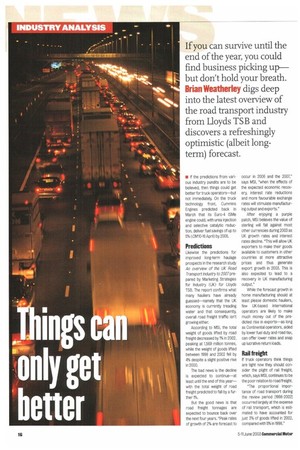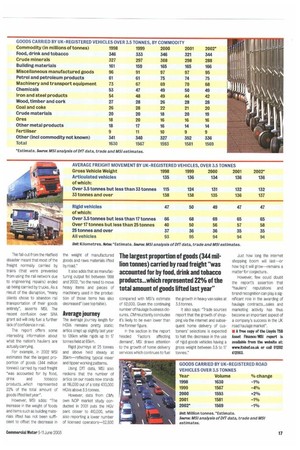If you can survive until the end of the year,
Page 16

Page 17

If you've noticed an error in this article please click here to report it so we can fix it.
you could find business picking up— but don't hold your breath. Brian Weatherley digs deep into the latest overview of the road transport industry from Lloyds TSB and discovers a refreshingly optimistic (albeit longterm) forecast.
• If the predictions from various industry pundits are to be believed, then things could get better for truck operators—but not immediately. On the truck technology front. Cummins Engines predicted back in March that its Euro-4 ISMe engine could, with urea injection and selective catalytic reduction, deliver fuel savings of up to 5% ( CM10-16 April) by 2005.
Predictions
Likewise the predictions for improved long-term haulage prospects in the research study An overview of the UK Road Transport Industry to 2007 prepared by Marketing Strategies for Industry (UK) for Lloyds TSB. The report confirms what many hauliers have already guessed—namely that the UK economy is currently treading water and that consequently, overall road freight traffic isn't growing either.
According to MSI, the total weight of goods lifted by road freight decreased by 1% in 2002, peaking at 1,569 million tonnes, while the weight of goods lifted between 1998 and 2002 fell by 4% despite a slight positive rise in 2000.
The bad news is the decline is expected to continue—at least until the end of this year— with the total weight of road freight predicted to fall by a further 1%.
But the good news is that road freight tonnages are expected to bounce back over the next four years. "Peak rates of growth of 2% are forecast to occur in 2006 and the 2007," says MSI, "when the effects of the expected economic recovery, interest rate reductions and more favourable exchange rates will stimulate manufacturing output and exports."
After enjoying a purple patch, MSI believes the value of sterling will fall against most other currencies during 2003 as UK growth rates and interest rates decline. "This will allow UK exporters to make their goods available to customers in other countries at more attractive prices and thus generate export growth in 2003. This is also expected to lead to a recovery in UK manufacturing output."
While the forecast growth in home manufacturing should at least please domestic hauliers, few UK-based international operators are likely to make much money out of the predicted rise in exports—as long as Continental operators, aided by lower fuel duty and road tax, can offer lower rates and snap up lucrative return loads.
Rail freight
If truck operators think things are tight now they should consider the plight of rail freight, which, says MSI, continues to be the poor relation to road freight.
"The proportional importance of road transport during the review period [1998-2002] occurred largely at the expense of rail transport, which is estimated to have accounted for just 3% of goods lifted in 2002, compared with 5%in 1998."
The fall-out from the Hatfield disaster meant that most of the freight normally carried by trains (that were prevented from using the rail network due to engineering repairs) ended up being carried by trucks. As a result of the disruption, "many clients chose to abandon rail transportation of their goods entirely", asserts MSI. The recent confusion over SRA grant aid will only fuel a further lack of confidence in rail.
The report offers some interesting information about what the nation's hauliers are actually carrying.
For example, in 2002 MSI estimates that the largest proportion of goods (344 million tonnes) carried by road freight "was accounted for by food, drink and tobacco products. ..which represented 22% of the total amount of goods lifted last year".
However, MSI adds: 'The increase in the weight of foods and items such as building materials lifted has not been sufficient to offset the decrease in
the weight of manufactured goods and raws materials lifted by road," It also adds that as manufacturing output fell between 1998 and 2002, "so the need to move heavy items and pieces of machinery used in the production of those items has also decreased" (see top table).
Average journey
The average journey length for HGVs remains pretty static; artics crept up slightly last year to 136km while rigids up to 17 tonnes held at 65km.
Rigid journeys at 25 tonnes and above held steady at 35km—reflecting typical mixer and tipper working patterns.
Using DIT data, MSI also reckons that the number of artics on our roads now stands at 116,000 out of a total 430,000 HGVs above 3.5 tonnes.
However, data from CMs own NOP market study conducted in 2001 puts the HGV pare closer to 410,000, while also reporting a lower number of licensed operators-52,600
compared with MSI's estimate of 62,000. Given the continuing number of haulage business closures, CMreluctantly concludes it's likely to be even lower than the former figure.
In the section in the report headed 'Factors affecting demand', MSI draws attention to the growth of home delivery services which continues to fuel
the growth in heavy van sales at 3.5 tonnes.
It also says: "Trade sources report that the growth of shopping via the Internet and subsequent home delivery of customers' selections is expected to halt the decrease in the use of rigid goods vehicles having a gross weight between 3.5 to 17 tonnes." Just how long the Internet shopping boom will last—or how big it will grow—remains a matter for conjecture.
Howevel; few could doubt the report's assertion that "hauliers' reputations and brand recognition can play a significant role in the awarding of haulage contracts...sales and marketing activity has thus become an important aspect of a company's success in the UK road haulage market".
U A free copy of the Lloyds TSB Asset Finance/MS! report is available from the website at: wvnvitsbatco.uk or call 01202 412003.
























































































































































































